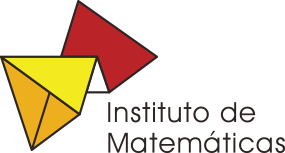Seminarios
- David Damanik, Rice University (online)
Johnson-Schwartzman Gap Labelling for Ergodic Jacobi Matrices
We consider two-sided Jacobi matrices whose coefficients are obtained by continuous sampling along the orbits of a homeomorphim of a compact metric space. Given an ergodic probability measure, we study the topological structure of the associated almost sure spectrum. We present a gap labelling theorem in the spirit of Johnson and Schwartzman. That is, we explain why the constant value the integrated density of states takes in a gap of the spectrum must belong to the countable Schwartzman group of the base dynamics. This talk is based on joint work with Jake Fillman (Texas State University) and Zhenghe Zhang (University of California, Riverside).
- Alfredo Deaño, Universidad Carlos III de Madrid (online)
Two tales about matrix valued orthogonal polynomials
- Maurice Duits, Royal Institute of Technology (KTH) (online)
Random tilings and (matrix-valued) orthogonal polynomials
- Ujué Etayo, Universidad de Cantabria (online)
On three mathematical problems connected by the 2-dimensional sphere
Finding stable complex univariate polynomials, equidistributing points on the 2-dimensional sphere and bounding a quantity that compares the norm of a polynomial with the product of the norms of its factors are three mathematical problems that belong historically to three different fields of mathematics: numerical analysis, potential theory and number theory. During this talk we will discover how this three problems are indeed intrinsically related. We will learn whether if there is an answer for the different problems and, more interestingly, what remains to be proven.
- María Ángeles García-Ferrero, Universidad de Barcelona (online)
A walk through exceptional orthogonal polynomials
A new age in orthogonal polynomials began in 2009 with the discovery of exceptional families. Since then, systems of exceptional Hermite, Laguerre and Jacobi polynomials have been obtained and described. In this talk, we will introduce exceptional orthogonal polynomials. We will focus on the most recent examples, which can depend on an arbitrary number of continuous parameters. We will also see the method to construct them from the classical polynomials. This is based on joint works with D. Gómez-Ullate, R. Milson and J. Munday.
- Francisco Marcellán, Universidad Carlos III de Madrid
Orthogonal Polynomials in weighted Sobolev spaces. Analytic theory and applications
In this talk we will analyze sequences of orthogonal polynomials with respect to an Sobolev inner product associated with a vector of positive Borel measures supported on the real line. First of all, a historical sketch of motivations for their study will be pointed out. In particular, we will focus the attention on the so-called coherent pairs of measures ([1]) and coherent pairs of measures of second kind ([2]). Second, we will emphasize some results concerning constructive methods of Sobolev orthogonal polynomials recently analyzed in [3]. Their connection with matrix analysis and operator theory as well as the convergence of Fourier series in terms of coherent pairs will be discussed for different cases of Sobolev inner products. Finally, some applications to the study of Boundary Value Problems for ODEs in the framework of spectral methods will be given (see [5]). For an overview on orthogonal polynomials in Sobolev spaces you can read [4].
References
1. A. Iserles, P. E. Koch, S. P. Norsett, J. M. Sanz-Serna, On polynomials orthogonal with respect to certain Sobolev inner products. J. Approx. Theory 65 (1991), no. 2, 151–175.
2. M. Hancco Suni, G. A. Marcato, F. Marcellán, A. Sri Ranga, Coherent pairs of measures of the second kind and associated Sobolev orthogonal polynomials: A functional approach. Submitted.
3. A. Iserles, M. Webb, Sobolev orthogonal systems with tridiagonal skew-Hermitian differentiation matrices. Studies Appl. Math. In press.
4. F. Marcellán and Yuan Xu, On Sobolev Orthogonal Polynomials. Expo. Math. 33 (2015), 308-352.
5. Xuhong Yu, Zhongqing Wang, Huiyuan Li, Jacobi-Sobolev Orthogonal Polynomials and Spectral Methods for Elliptic Boundary Value Problems, Commun. Appl. Math Comput. 1 (2019), 283-308.
- Andrei Martínez-Finkelshtein, Baylor University y Universidad de Almería (online)
Multi-applications of multi-orthogonality
Orthogonal polynomials (OP) belong in a toolbox of any branch of modern science. They appear in multiple applications in engineering, physics, computer science and mathematics. One of the secrets of their ubiquity is that they are on the crossroads of several mathematical branches: analysis, approximation theory, spectral theory, special functions, combinatorics, mathematical physics, numerical analysis, to mention a few. OP have also stimulated the development of new tools and approaches to their study. Their cousins, multiple orthogonal polynomials (MOP), defined by a combination of several orthogonality conditions, are much less known. Their origins can be traced back to the works of Hermite in number theory. However, a general theory of MOP started to develop basically less than 40 years ago. As it often happens, this was simultaneous to appearance of new applications, which brought up new challenges requiring new tools, some of them borrowed from other branches of analysis. In this talk I will try to illustrate some parallels and some striking differences between OP and MOP, as well as to mention some possible emerging applications of MOP.
- Salvador Pérez Esteva, IMUNAM-Cuernavaca
Inverse spectral problem for the Dirichlet to Neumann map
The field of inverse problems in differential equations has a long history. I will briefly mention a couple of emblematic (my favorite) inverse problems including Calderón’s problem and the classical spectral problem: Can one hear the shape of a drum? Then I would like to share with you a few ideas that my colleagues and I have been thinking about in the last months concerning an inverse problem for the Dirichlet to Neumann map (D-N) map in the sphere. This map is by the way the basic ingredient of Calderón's problem. This research follows the lines of the work of A Uribe, V. Guillemin searching for certain invariants in spectral problems for perturbations of the Laplacian on the sphere.
- Miguel Piñar, Universidad de Granada
On Multivariate Orthogonal Polynomials and elementary symmetric functions
See abstract.








